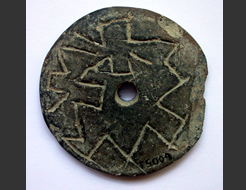|
||||||||||||||||||||||||||||||||
|
|
Museum of: Athens | |||||||||||||||||||||||||||||||
| Name of the artefact: Spindle - whorl | ||||||||||||||||||||||||||||||||
|
Clay discoid spindle-whorl with incised symbols, two of
which depict human figures. |
||||||||||||||||||||||||||||||||
|
WHERE IS IT AND MAIN
CHARACTERISTICS |
STATE |
|||||||||||||||||||||||||||||||
|
Department: |
Prehistoric |
Preservation: |
Very good | |||||||||||||||||||||||||||||
|
Inventory number: |
6005.1 |
Restauration: |
No restored | |||||||||||||||||||||||||||||
|
Name of the artefact: |
Spindle - whorl |
Completeness: |
Complete | |||||||||||||||||||||||||||||
|
Object type: |
Tool |
|||||||||||||||||||||||||||||||
|
Material: |
Clay |
|||||||||||||||||||||||||||||||
|
Methof of manufacture: |
Hand made |
|||||||||||||||||||||||||||||||
|
Decoration
type: |
Incision |
|||||||||||||||||||||||||||||||
|
Distinctive mark: |
Incision |
|||||||||||||||||||||||||||||||
|
DIMENSIONS |
PERIOD OF USE |
|||||||||||||||||||||||||||||||
|
Length (mm): |
- |
Epoque: |
Neolithic |
|||||||||||||||||||||||||||||
|
Heigth
(mm): |
- |
Culture: |
- |
|||||||||||||||||||||||||||||
|
Diameter
(mm): |
52 |
Period: |
Final Neolithic< |
|||||||||||||||||||||||||||||
|
Width (mm): |
- |
Face: |
- |
|||||||||||||||||||||||||||||
|
Thickness (mm): |
5 |
Absolute chronology: |
4500-3300BC |
|||||||||||||||||||||||||||||
|
Weight
(g): |
22.8 |
|||||||||||||||||||||||||||||||
DISCOVERY |
||||||||||||||||||||||||||||||||
|
Date: |
1902 |
Country: |
Greece |
|||||||||||||||||||||||||||||
|
District: |
Thessaly |
Town hall affiliation: |
Volos |
|||||||||||||||||||||||||||||
|
Village: |
Dimini |
Discovery findspot: |
Neolithic settlement of
Dimini |
|||||||||||||||||||||||||||||
|
Condition of discovery: |
Archaeological excavation |
Discovery type: |
Deposit |
|||||||||||||||||||||||||||||
|
ANALYSES – DETERMINATIONS |
FILLED IN BY |
|||||||||||||||||||||||||||||||
|
Type: |
- |
Name: |
Alexandra Christopoulou |
|||||||||||||||||||||||||||||
|
Laboratory: |
- |
Institution: |
National Archaeological Museum -
Greece |
|||||||||||||||||||||||||||||
|
No./Code: |
- |
Date: |
21/11/2005 |
|||||||||||||||||||||||||||||
|
DEEPENINGS |
||||||||||||||||||||||||||||||||
|
Morphology of the object: |
||||||||||||||||||||||||||||||||
|
Clay hand-made spindle-whorl in the shape of a disc. It
is the simplest type in this category of tools. Spindle whorls together
with loom-weights constitute the two groups of archaeological finds, which
are related and become evident for the weaving practice.The main purpose
of the spindle whorls is to increase the spinning of the spindle, thus
their important characteristics are a) their diametre and b) their weight.
Considering the above, there is variety in both. Still the diametre lies
between 3-5cm, while their weight is about 20gr. According to ethnographic
parallels, when a similar in shape object is less than 2cm in diametre, it
is not possible to function as a spindle whorl. The diametre of the
central hole, in which a spindle whorl is stabilised at the one edge of
the spindle, is usually around 7-8mm. The central hole of the particular
object presented here (no6005.1) is 6.5mm in diametre. The weight of the
spindle whorl depends on the desired thickness of the thread as well as on
the length of the fibres. The longer the fibre is the heavier the spindle
whorl should be. Line, for instance, has long fibres, while wool has
shorter ones. |
||||||||||||||||||||||||||||||||
|
Decoration: |
||||||||||||||||||||||||||||||||
|
These tools are found plain or decorated with
incisions. The main characteristic of this spindle whorl is its specific
incisions. The entire round surface has been incised before baking. The
incision gives the impression of a clumsy scratching, without specific
design. This opinion is strengthened when compared with other decorated
spindle whorls, like no 6005.4 (photo). However, a closer look to this
clumpsy incision shows that the lines on the surface are not decorative,
but indicative of a script. Actually, the lines depict two human figures
in abstract shape. The depiction of human figures incised or painted on
neolithic objects is characteristic in the late and final neolithic
periods. |
||||||||||||||||||||||||||||||||
|
Inscription: |
||||||||||||||||||||||||||||||||
|
- |
||||||||||||||||||||||||||||||||
|
Analogies: |
||||||||||||||||||||||||||||||||
|
An incised human figure is depicted on a late neolithic
vase no 5926 (photo). The incised decoration on it, neat and clear is
interupted by an incised human figure. Its presence changed this vase to
an anthropomorphic utensil and altered possibly its function from common
use to another specific, still unknown, purpose. |
||||||||||||||||||||||||||||||||
|
Interpretation: |
||||||||||||||||||||||||||||||||
|
The presence of human figures on this spindle whorl
could indicate that the owner, most probably a woman, wanted possibly to
communicate a message, or that it was her signature (of recognition).
|
||||||||||||||||||||||||||||||||
|
Bibliography: |
||||||||||||||||||||||||||||||||
|
- |
||||||||||||||||||||||||||||||||

